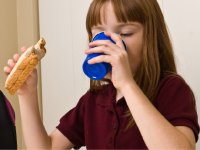Spread the Word About Summer Meals for Students
Your content has been saved!
Go to My Saved Content.As a society, we tend to romanticize "summer break" in discussions about school. For some of us not involved in education (and even for some who are), what comes to mind is kids on the beach, in summer camp, playing sports, reading (for fun!) under a tree, or another variation on the idea that activities dominate this time when students are free from the pressures of school.
Educators see more nuance, often recognizing potential benefits to summer break while also having concerns that kids will get too much screen time and too little activity, and knowing that when school starts again in the fall, many students will have experienced the "summer slide" -- loss of ground in their academic skills.
Not often raised is the issue of summer hunger. For some kids, a break from school means a break from the school meals that they rely on.
Summer Nutrition
Nearly 20 percent of U.S. households with children under the age of 18 were food insecure in 2013, according to the U.S. Department of Agriculture. That means they lacked access to enough food ensuring an active, healthy life for all household members. While only adults were affected in nearly half these households, overall, 8.6 million children were food insecure.
We as a nation recognize the importance of guaranteeing that all children have access to healthy food, as evidenced by our commitment to the national school lunch and breakfast programs -- programs that provide meals to low-income children at school. But when school's out, do these children have stable and secure access to healthy food? Unfortunately, not always.
Only one in seven of the children who receive free or reduced price meals during the school year continues to receive meals during the summer, according to the Food Research and Action Center (FRAC).
The good news: There are programs that can help these children have healthy meals, including the federally-funded Summer Food Service Program and the National School Lunch Program. They can operate nearly anywhere that children congregate when school is out -- parks, housing projects, houses of worship, YMCAs, summer camps, schools, and others can serve as sponsors.
All meals meet U.S. Department of Agriculture nutritional guidelines. And in many cases, they are accompanied by activities that help keep kids active and learning over the summer months. We just need to make sure that more children are able to take advantage of them.
How Can Educators Help?
As FRAC points out, increasing participation in these programs requires three things: enlisting sponsors, increasing the number of sites where meals are served, and ensuring that families know about the programs. While educators can help in all three of these areas, they are particularly well positioned to help with the third. How?
First, determine that at least one person at your school (be it the principal, social worker, nurse, a teacher, a cafeteria worker, or another) knows about the availability of summer meals in your community -- and designate that person to serve as an on-site "expert." When anyone at the school gets detailed questions, refer them to that person.
If no one is familiar with local options, call the National Hunger Hotline at 1-866-3-HUNGRY to inquire, or visit the website, WhyHunger and search by location (note that the results will show all sites with food available, not just those targeted at children).
Or look on your state's department of education or public health website (or call) for more detailed information. In some communities, you can call 211 to find a site close to your school or neighborhood.
Once you know where kids can go for summer meals, let families know. Some ways to do so:
- Distribute flyers with the location and contact information of nearby sites. Send them home in backpacks or with report cards or summer reading lists. Have them available at end-of-year events (graduations, track and field days, and so on). Post them in the school office and cafeteria.
- Circulate information electronically. Include it on the school and district websites. Promote it on social media.
- Target low-income populations. In addition to messages that go out to the whole school population, do follow-up phone calls or home visits with students most likely benefit from these services.
- Enlist school partners to help spread the word. Out-of-schooltime partners that work with students (such as YMCAs, Boys and Girls Clubs, Scouts, Little Leagues, and so on) can let families know about summer meal programs -- and you might be able to convince them to serve as sponsors in the future. Ask local food banks, WIC clinics, libraries, and other partners to hang posters and distribute flyers as well.
Summer break can be a rejuvenating time for both students and educators. By ensuring all students have access to the healthy food that they need to thrive, we can help them make the most of it.
